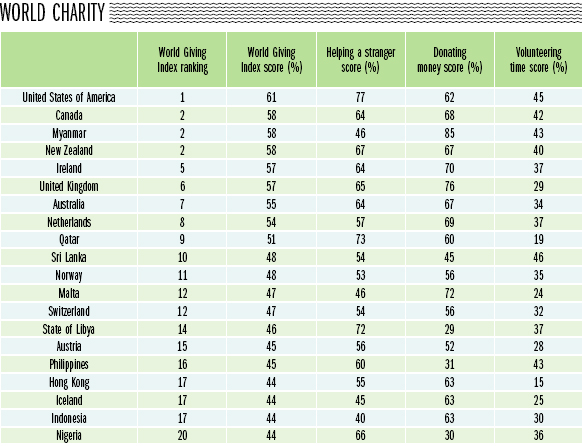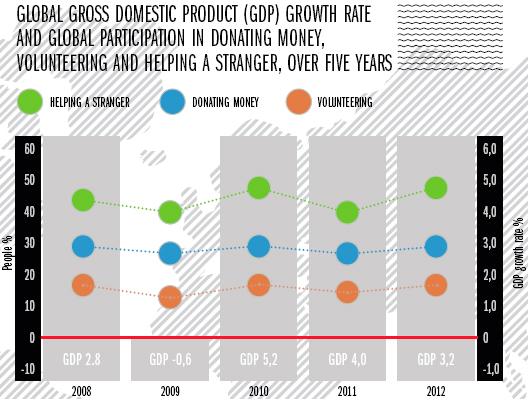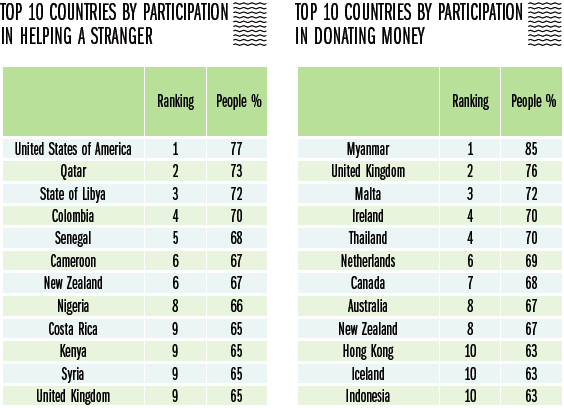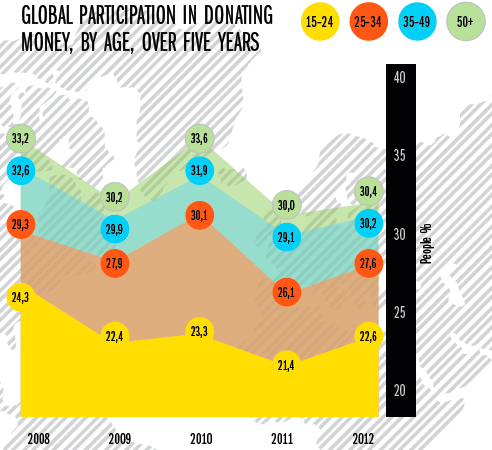
Despite the slowdown in the world economy, the total amount of giving to charity has continued to increase, according to the British organization Charities Aid Formation. The World Giving Index 2013 reveals another curious result: It is the developing countries that are driving growth in charity and the material wealth of individuals isn’t always a sign of their willingness to donate to a good cause.
The World Giving Index 2013 looks at data collected in 2012 from 135 countries and that account for 94% of the world’s population. The study is based on Gallup polls, conducted as part of their World Poll initiative. The statistical data obtained is then interpreted by analysts at the British Charities Aid Foundation (CAF) into three categories: helping a stranger, donating money to charity organizations, and volunteering. The total of these three components determines a country’s ranking in the Index.
The Index leader this year was the United States, which previously held this title in 2011, passing the top spot to Australia in 2012. America came out on top in charitable donations because Americans gave more to needy strangers in 2012. And even while there was relatively stable distribution among the top places across Western countries, this year’s Index was a direct confirmation of a global trend – that people from developing countries are more and more frequently getting involved in such social processes. If you look at the number of people active in charitable giving in absolute numbers and not as a percentage, then India and China are clear leaders. On average, 654 million Indians per month gave some form of help in one of the three categories, while in China it was 531 million and in the U.S. it was 470 million.
Growth in charitable donations is primarily due to the fact that more people are directly helping the needy. Compared with previous editions of the Index, this amounted to 200 million more people, or twice the increase in the number of people who volunteer or make cash donations.
It is unusual that there was a three-way tie for second place in the 2013 Index among Canada, Myanmar, and New Zealand. In each of these countries, 58% of the population participated in one form of charity or another during the month the surveys were conducted. However, the preferences of these countries varied greatly. The most popular way to do a good deed in Myanmar and Canada was through financial assistance to charitable organizations (85% and 68%, respectively), while New Zealanders, in addition to financial donations (made by 67% of the population), think that personal aid to needy strangers is just as important. Topping the Index in 2012 and 2010, Australia dropped this year to seventh behind Ireland and the UK. Among the other top ten charitable countries were the Netherlands, Qatar, and Sri Lanka.
On the topic of gender preferences, it’s worth noting that women universally much prefer to donate money while men prefer to give their time, whether through personally helping strangers or through volunteer work. There are also differences among age groups.

It is no secret that the older a person is, the more likely it is that he or she wants to help others without compensation. This axiom is confirmed in all editions of the Index’s publication, beginning in 2010. But CAF analysts revealed that last year, the gap between the 50+ age group and others closed slightly, thanks to the younger generation’s becoming more involved. Compared to 2012, the number of people who give money to charity grew by 1% in the 2013 Index in the 15-24, 25-34, and 35-49 age brackets, while the 50+ group grew by just 0.4%.

Younger well-to-do people are more cautious in choosing the organizations they will donate to, according to the Innovation in Giving Fund. A sociological survey of wealthy people conducted by Scorpio Partnership shows that 58% of all sponsors under age 30 spend weeks or even months searching for projects to support with their money. Younger people are also more likely to follow up the social impact and results of their donations – 81% versus 72% of those over 45 years of age.
The Poorer, The More Generous
We might logically assume that the higher the income of a nation’s citizens, the more likely and possible it is that they will donate to charity, which is why the World Giving Index 2013 is surprising.


The country giving more financial support to charitable organizations than any other is Myanmar, where 85% of adults stated that they give money to charity. Myanmar also happens to be one of the least developed countries in the world and has very low income per capita. This fact only confirms that financial contributions depend less on the wealth of a donor and more on his desire to help. People who have themselves as some point been needy are more willing to part with money to help others. This trend is confirmed by the fact that eight of the top ten countries in the Index do not belong to the G20, which collectively represents 90% of the global gross national product. In absolute qualitative terms, another developing county, India, gives more financial aid to charities than any other (more than 244 million people in the month of the survey).
Text: Olga Irisova